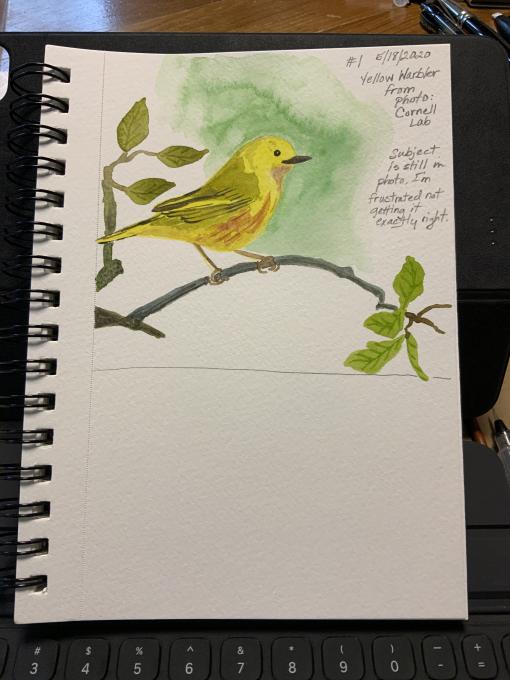The Cornell Lab Bird Academy › Discussion Groups › Nature Journaling and Field Sketching › Jump Right in!
-
Drawing from an image was fine. Drawing while they are flying is very difficult. What came easily was obtaining the shape and size of the warbler. It was adding the details that was more tricky because I tend to go overboard. I should have drawn the complete branch and leaves. Perhaps I would add details at home instead of in the field.
-

-
 Here is my Warbler drawing. Sorry that it's not very clear, my computer camera isn't very good.
Here is my Warbler drawing. Sorry that it's not very clear, my computer camera isn't very good. -
 Drawing from a photograph is fine - it allows me to take my time drawing, however, it feels like “flat”; a 2D image is being copied. It is good if i cant stay outside for long due to the weather conditions. The joy of observing is not there though.
I noticed the texture of the Podotheca as well as the form of the beak. Noticing the details is very important in nature journaling; it us part of sensing the bird being watched. It is of importance to point that observing bird’s behaviours for a while is enriching our visual memory. So that when we sketch it from a photograph -even if the photo is a bit blurred due to its fast movement- we will still be able to draw it accurately.
After uploading the image, i noticed that I forgot to add the name & information of the bird ^_^;
Drawing from a photograph is fine - it allows me to take my time drawing, however, it feels like “flat”; a 2D image is being copied. It is good if i cant stay outside for long due to the weather conditions. The joy of observing is not there though.
I noticed the texture of the Podotheca as well as the form of the beak. Noticing the details is very important in nature journaling; it us part of sensing the bird being watched. It is of importance to point that observing bird’s behaviours for a while is enriching our visual memory. So that when we sketch it from a photograph -even if the photo is a bit blurred due to its fast movement- we will still be able to draw it accurately.
After uploading the image, i noticed that I forgot to add the name & information of the bird ^_^; -
-
Drawing the Yellow Warbler helped me generalize what I Thought a yellow warbler looked like. I paid more attention to the shape of the body and to the details of the red stripes. Also, I saw how the values such as dark and darker helped define the wings, the beak and the eye. I'm aware how much easier it is to paint something that doesn't keep flitting around! I'm not sure a yellow warbler would hold still for me if I saw it in a bush!
-
I like drawing from the photo. I'm slow, and given that the image is a photo, the image moves much slower than I ... Getting the proportions right is a challenge for me. I really made attention to how the skeletal and the muscular structure is present in the photo. For example, I tried to imagine how the beak was not an appendage, but was an extension of the bird's skull. As well, I wanted to capture how the upper part of the covert of the wing had some contour. This exercise sharpened by observation skills. - I'm excited to see how I hopefully improve over the course.

-
I've always loved just sitting and observing nature. I've done a bit of journalling on some journeys I've taken in my VW camper. I'm not feeling very confident about it, but still when I look at the sketches or watercolors it brings back such wonderful feelings. I want to learn more about how to do this and have it become so natural that I don't hesitate to do it often. I love writing down what I see, but I don't necessarily do it in a very organized way. A nature journal at this time seems perfect for me. I loved seeding the examples of what other people did. I'd like to practice quick sketches of birds that show impression, behavior, posture, etc. I'm hoping by drawing birds and adding details it will help me recognize them when I see them in the field. I'm so excited to be doing this now! It keeps me from feeling stuck in my townhome! Laurie
-
1. Just by chance over the last few days, before I joined the course, I had tried to draw a couple warblers from photos so I was thinking, okay, I've done this a couple times already; I can do this. However, I tried to draw without too much erasing because I felt in the field you may have to draw faster before the bird flies away. This made it challenging to get the proportions right. I wanted to include the branch because I feel that adds interest to the drawing but when I looked at my finished drawing I realized the bird was proportionally much larger than the branch. And the proportions of the bird are a little off.
![IMG_1062[11213]](data:image/gif;base64,R0lGODlhAQABAAAAACH5BAEKAAEALAAAAAABAAEAAAICTAEAOw==) Since I have been paying attention to the warblers and the parts of songbirds recently I feel it came a little easier to figure out the details of the feathers.
2. There are several things I might not have noticed from the photo if I didn't draw it:
Since I have been paying attention to the warblers and the parts of songbirds recently I feel it came a little easier to figure out the details of the feathers.
2. There are several things I might not have noticed from the photo if I didn't draw it:
- the black color in the wings;
- the gray shading on the head and back,
- the different colors in the bill; and
- the different colors and moss (?) on the branch
-
Hello Nancy, This might be off topic but your minimalistic way of sketching reminds me of the Finnish artist and illustrator Emmi Jormalainen . In fact, your drawing made me consider going back to the ink sketching instead of colouring the birds. Sometimes, black and white sketching forces us to think deeply into the details. Best, Alyazia
-
1. Wow, that went better than I thought! I remember looking at it and thinking "wow, I can't capture these fine details" and then I ended up drawing the bird, without more of the foliage than the branch it is clinging to, and getting more of the bird's details than I expected! 2. The overall shape went better than I expected, but the gaze and facial expression absolutely eludes me. The result is kind of charming, but it's not the look the warbler is giving to the camera, at all. Also, without the color, it's really hard to convey with strokes the complexities of shading of this bird's feathers. I haven't ever seen one of these warblers in real life, but I found myself using the anatomy I've learned from bird books and from a long ago ornithology class, to capture what I did of the different feather groups and their coloration. Then again, I just realized that by choosing to focus on the bird I really haven't captured a bit of which plant this bird is perching on, and in my mind's eye I don't have a solid guess as to what sort of tree or shrub it is. When I scroll back up, there's lichen, and I can begin to make a guess, but I just hadn't focused on it at all while drawing. And if I look down, I see other people _did_ try to play with color, and now I can't wait until my watercolors arrive. This was a lot of fun to do.

-
 Not bad for my first attempt at drawing in several years. Even after several rounds with the eraser I still didn't get the shape quite right, but it's definitely recognizable as a bird, and maybe even as a yellow warbler. Drawing from the photo gave me an opportunity to see all the features and identify which bits were shadow and which were actual markings, and I don't think my observations would have been nearly as detailed if I weren't drawing. Obviously birds in the wild generally aren't going to sit still for this kind of observation, but I think practicing this kind of drawing from photos might train me to see those kinds of details more quickly when I'm looking at a moving target.
Not bad for my first attempt at drawing in several years. Even after several rounds with the eraser I still didn't get the shape quite right, but it's definitely recognizable as a bird, and maybe even as a yellow warbler. Drawing from the photo gave me an opportunity to see all the features and identify which bits were shadow and which were actual markings, and I don't think my observations would have been nearly as detailed if I weren't drawing. Obviously birds in the wild generally aren't going to sit still for this kind of observation, but I think practicing this kind of drawing from photos might train me to see those kinds of details more quickly when I'm looking at a moving target. -
I have to say I felt a little intimidated looking at the photo. But after sketching and using the water colors, I felt a lot more confident. I will be focusing on getting more detail out of the paint, I feel this is most challenging. I didn't spend a whole lot of time studying the photo, I seemed to have focused mostly on the Warbler.

-
I think you did a really good job with the overall shape of the bird and the colours. I love the way you captured the dark black of the eye (with the little white dot of reflection) and the black in the wings and the tail. The notes regarding the color or other characteristics is a good idea, especially in the field, when the bird may fly away before you get to finish the painting.
-
@Nancy Thank you Nancy, This was the first time I used watercolor paints. I always thought of myself as Not a painter, I always used pencils, felts in the past when making pictures.
-
-
1. The drawing itself was not that difficult for me. I draw birds since my early childhood... But the most difficult thing is to put watercolor on my drawing. My medium is acrylic or more than watercolor. I try to use a yellow wash above olive-green back of the bird (on the greater, medium, and lesser covers). The eye is not exactly round because the head is a little bit turned. I always try to paint some little point around the (= eyering) around the eye! I directly saw from where the light is coming on the photo and put shade under the right-wing and not far from the tail. Drawing from a photo is easy because I can always look precisely at it and see what is correct or wrong. I only concentrate on trying to represent the bird the best I can. I know how to paint a branch and increase it's roundness take into account the shade and light! 2. If I had to paint that bird for nature journaling, I think I might to try to draw the bird faster and put only a little bit of color (with water colored pencils more than watercolor). I probaly will add some details of the lichen and leaves...
-

-

-
Hi Géry, what are the type of colours used in your drawing? btw, i liked the lynx as well :)
-
-
1. Some of the proportions were difficult among the various objects. 2. When drawing, I noticed more detail in the branch and what was on it besides the warbler.
-
I was asked to write an article for an employer's social media post, and I decided to focus on sketching (though I don't mention the sketching part until the end.) Some novice sketchers might appreciate my struggle! https://operaflute.blogspot.com/2020/05/a-stay-at-home-order-sketches-on-dining.html
-
I was afraid to tackle the watercolors, but that probably would have been a better option than the pencils.

-
It was more difficult than I thought it would be to capture the posture of the little bird and I was a bit confused as to what details to add. I am really enjoying working with the watercolor pen but it will take a while to master. Right now I'm overworking the color and want to try experimenting with some other techniques.

-
I enjoyed the fact that the Yellow Warbler wasn't moving! I needed to look at the details over-and-over and revise-revise-revise the sketch when something didn't look right (e.g., eye placement). I was fortunate to have several living (YEWAs) encouraging me along outside my cabin as I worked. I hear them all the time but getting a look is a challenge. I wonder if I will every be able to draw from a glimpse... Feather placement on the wings would have been extremely difficult without the photo. I could have spent hours trying to get them right but this was a supposed to be sketch. Compared to photography, I really liked to be able to annotate my drawing. John

-
It's surprising how much fear arose every step of the way on this drawing, the first mark, erasure, adding color, adding ink. I think that's why I've put off starting the course. I keep saying I'm to busy, but that's probably just masking the fear. (The supremely organized sock drawer isn't terribly fulfilling.) And I learned so much just by staying with this image for a few days, the parts of the wing, the loose grip of one claw. The yellow warbler is olive and amber and black!
-

-

-
This is the 2nd time I am taking this class - thought it was a great idea to try everything again. It is alot easier to draw from a photo, much easier to take the time to see the shape and colors of the bird. I do like drawing from nature, though. It is nice to be outside and there is something organic about drawing on the fly. My yellow warbler drawing did not turn out as nice as the 2d time I drew it from taking the course the first time. Oh well, some days I am better than others at drawing.

-
 This was a fun exercise.....and I took my time to try to capture proportion and some detail. It will be fun to compare at the end of the course. The photo was beautiful to work from, plus you have the luxury of time. Drawing live in nature will definitely be more of a challenge (:
This was a fun exercise.....and I took my time to try to capture proportion and some detail. It will be fun to compare at the end of the course. The photo was beautiful to work from, plus you have the luxury of time. Drawing live in nature will definitely be more of a challenge (: -
It is difficult to decide when to stop! Should I keep adding details or call it quits? It begins to look overworked, the longer I keep painting. I think/hope painting directly from nature will allow me to capture more of the personality, or movement will make it more interesting. Comparing my work to the photograph is defeating. This first attempt did not achieve results I had hoped for. My warbler does not look alive.

-
Oh, Karen, please don't feel defeated! You have so much going on in your drawing and painting.The colors, the proportions, the crooks and curves of the leaves and branches, and curves in his feet make it all look alive! And , remember, this is what you are to compare your last drawing of him to at the end of the course! Enjoy!!!
-
Hi Karen. Yes, like Cynthia said, please do not get discouraged or defeated. Know when to stop is hard, but I am pleased with the results of your drawing and how your use, especially the shading and blending, of the watercolors was done. They give depth and contrast to the bird’s features.
-
Read More:
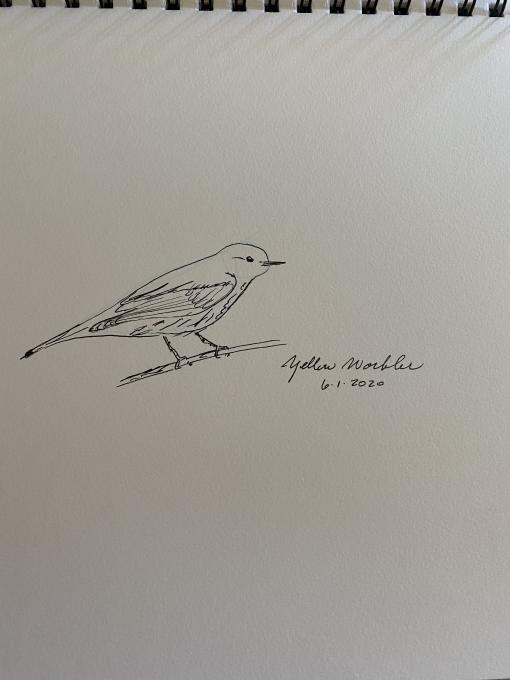
 Here is my Warbler drawing. Sorry that it's not very clear, my computer camera isn't very good.
Here is my Warbler drawing. Sorry that it's not very clear, my computer camera isn't very good. 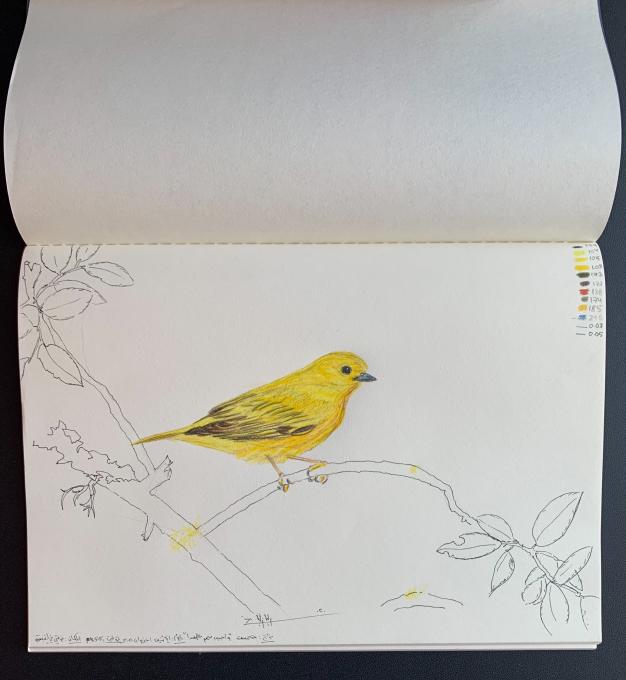 Drawing from a photograph is fine - it allows me to take my time drawing, however, it feels like “flat”; a 2D image is being copied. It is good if i cant stay outside for long due to the weather conditions. The joy of observing is not there though.
I noticed the texture of the Podotheca as well as the form of the beak. Noticing the details is very important in nature journaling; it us part of sensing the bird being watched. It is of importance to point that observing bird’s behaviours for a while is enriching our visual memory. So that when we sketch it from a photograph -even if the photo is a bit blurred due to its fast movement- we will still be able to draw it accurately.
After uploading the image, i noticed that I forgot to add the name & information of the bird ^_^;
Drawing from a photograph is fine - it allows me to take my time drawing, however, it feels like “flat”; a 2D image is being copied. It is good if i cant stay outside for long due to the weather conditions. The joy of observing is not there though.
I noticed the texture of the Podotheca as well as the form of the beak. Noticing the details is very important in nature journaling; it us part of sensing the bird being watched. It is of importance to point that observing bird’s behaviours for a while is enriching our visual memory. So that when we sketch it from a photograph -even if the photo is a bit blurred due to its fast movement- we will still be able to draw it accurately.
After uploading the image, i noticed that I forgot to add the name & information of the bird ^_^; 

![IMG_1062[11213]](https://academy.allaboutbirds.org/wp-content/uploads/hm_bbpui/706137/vfmr4kz3j0ixbi67d7orz464taywrjdr.jpg) Since I have been paying attention to the warblers and the parts of songbirds recently I feel it came a little easier to figure out the details of the feathers.
2. There are several things I might not have noticed from the photo if I didn't draw it:
Since I have been paying attention to the warblers and the parts of songbirds recently I feel it came a little easier to figure out the details of the feathers.
2. There are several things I might not have noticed from the photo if I didn't draw it:

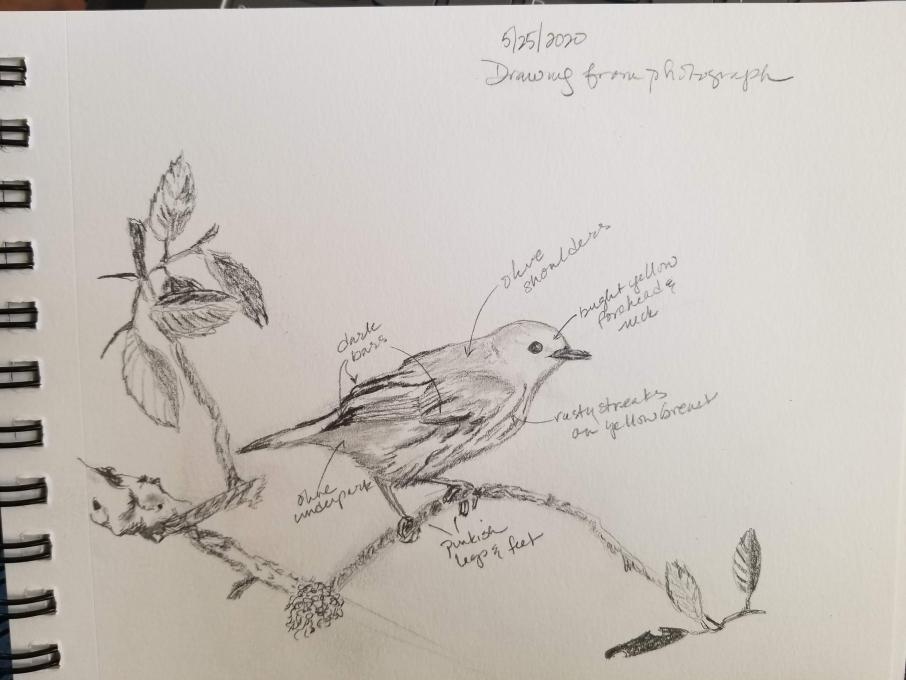 Not bad for my first attempt at drawing in several years. Even after several rounds with the eraser I still didn't get the shape quite right, but it's definitely recognizable as a bird, and maybe even as a yellow warbler. Drawing from the photo gave me an opportunity to see all the features and identify which bits were shadow and which were actual markings, and I don't think my observations would have been nearly as detailed if I weren't drawing. Obviously birds in the wild generally aren't going to sit still for this kind of observation, but I think practicing this kind of drawing from photos might train me to see those kinds of details more quickly when I'm looking at a moving target.
Not bad for my first attempt at drawing in several years. Even after several rounds with the eraser I still didn't get the shape quite right, but it's definitely recognizable as a bird, and maybe even as a yellow warbler. Drawing from the photo gave me an opportunity to see all the features and identify which bits were shadow and which were actual markings, and I don't think my observations would have been nearly as detailed if I weren't drawing. Obviously birds in the wild generally aren't going to sit still for this kind of observation, but I think practicing this kind of drawing from photos might train me to see those kinds of details more quickly when I'm looking at a moving target. 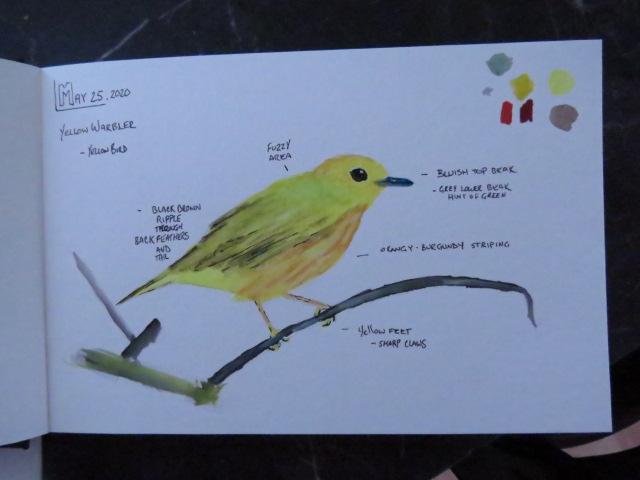
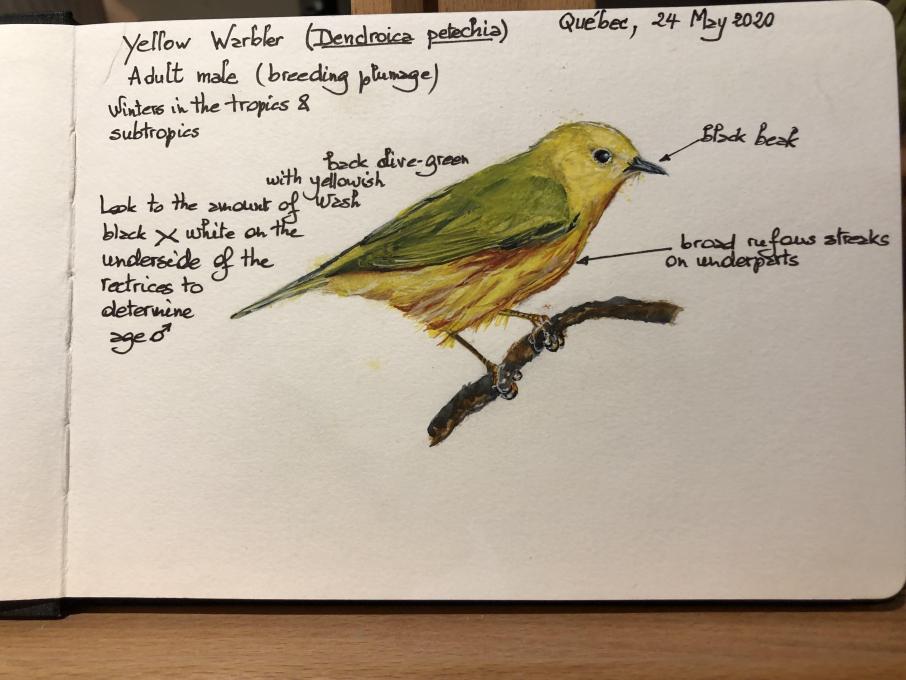
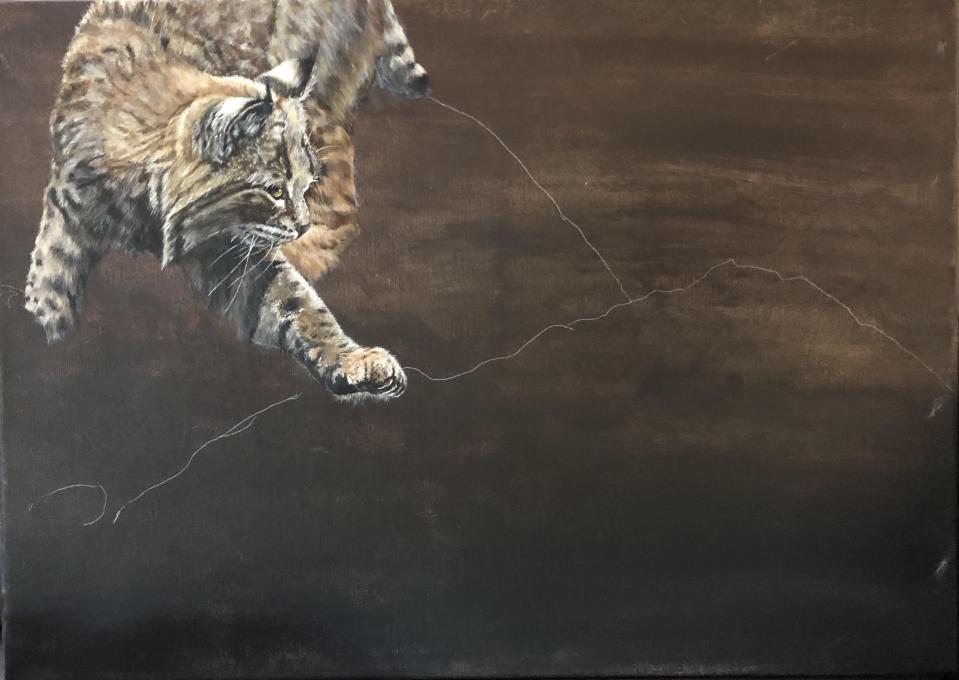
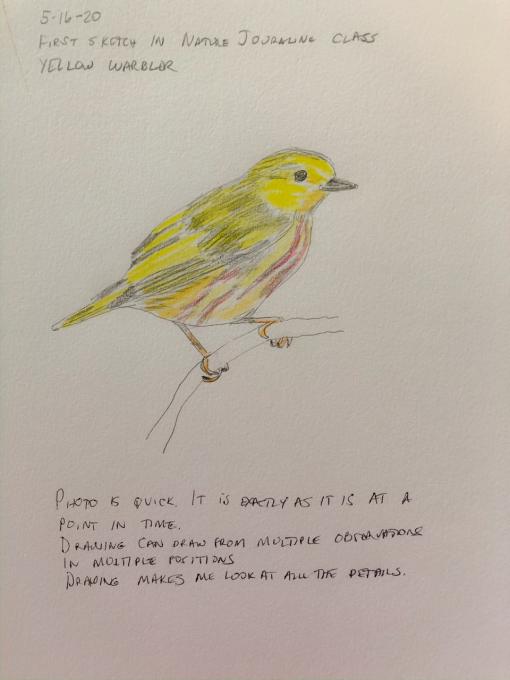
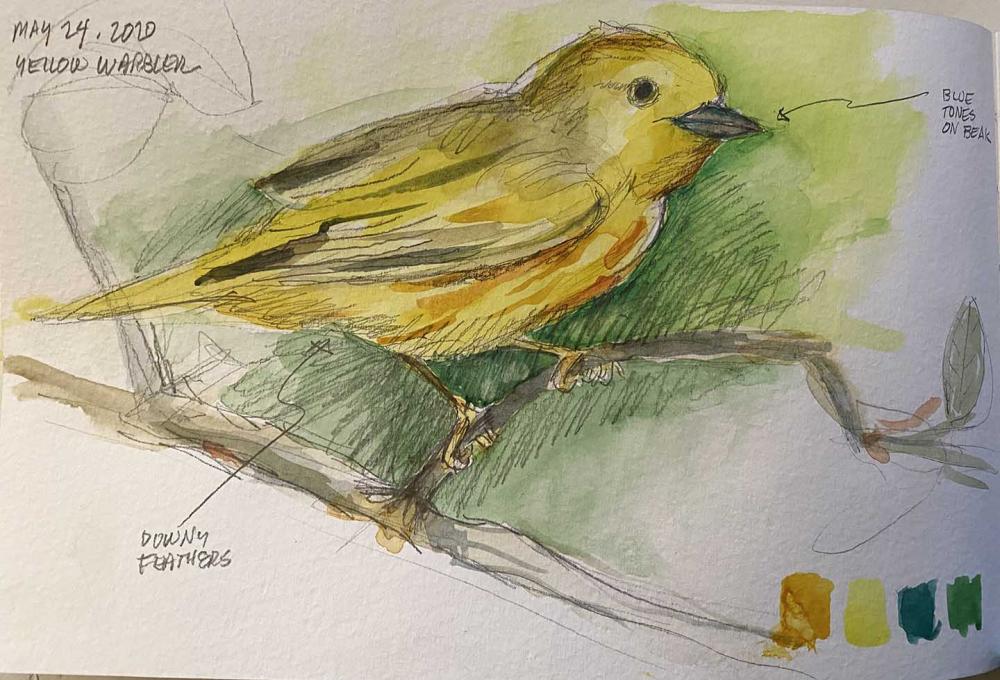


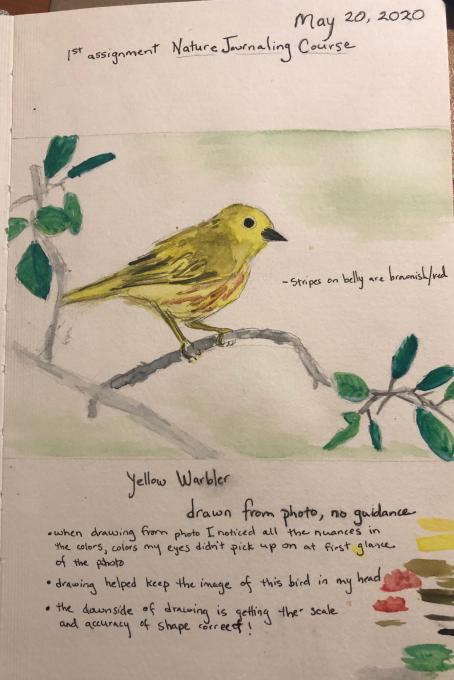
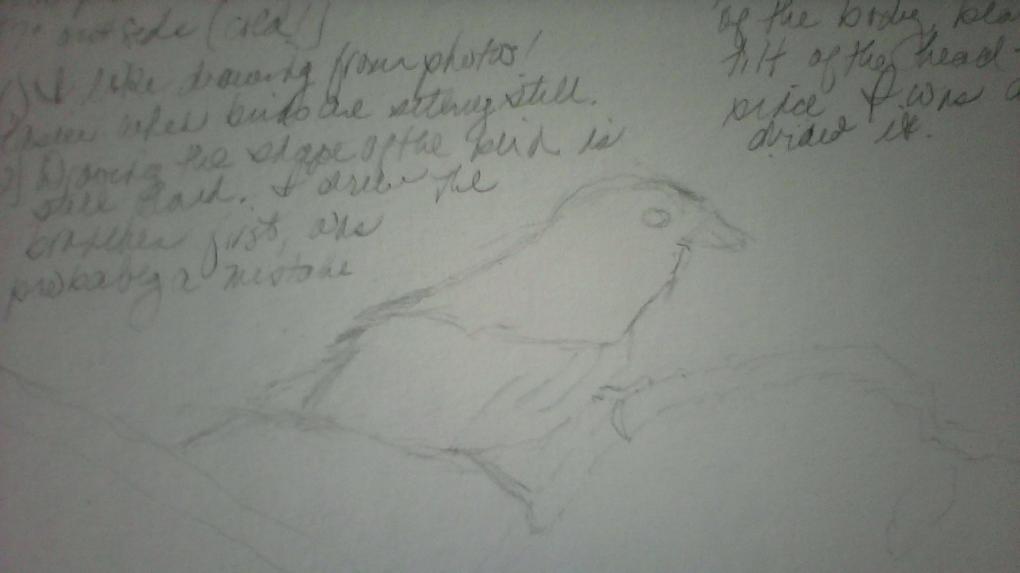
 This was a fun exercise.....and I took my time to try to capture proportion and some detail. It will be fun to compare at the end of the course. The photo was beautiful to work from, plus you have the luxury of time. Drawing live in nature will definitely be more of a challenge (:
This was a fun exercise.....and I took my time to try to capture proportion and some detail. It will be fun to compare at the end of the course. The photo was beautiful to work from, plus you have the luxury of time. Drawing live in nature will definitely be more of a challenge (: 